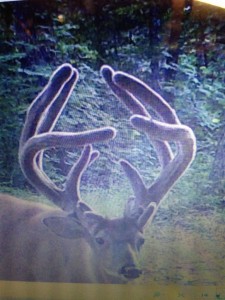 Velvet antlers grow via a complex system of blood vessels, which causes them to be hot to the touch. Top whitetail scientist Dr. Grant Woods notes, “There is so much blood carrying protein and minerals to a buck’s antlers this time of year that even small antlers are easily detected by thermal imaging devices. Antler tines show up like neon signs when flying over with thermal cameras in summer.”
Velvet antlers grow via a complex system of blood vessels, which causes them to be hot to the touch. Top whitetail scientist Dr. Grant Woods notes, “There is so much blood carrying protein and minerals to a buck’s antlers this time of year that even small antlers are easily detected by thermal imaging devices. Antler tines show up like neon signs when flying over with thermal cameras in summer.”
Tiny hairs on the velvet stick out and make the antlers look bigger than they are. The hairs act as a radar system so the buck won’t bump into trees, fence posts, etc. and damage his soft antlers.
Sebum, a semi-liquid secretion, on the hairs gives the velvet a shiny look. Sebum acts as an insect repellent to keep biting flies off a buck’s rack and face.
Read more about velvet antlers here.







Saw one today.
She was 6-10 feet away from me before she realized I was walking down my driveway. Absolutely beautiful!!! I described her later to my son as having large “Mossy antlers”. We ended up debating on whether or not she was female or male. I feel privileged to have been in her grace. Thank you for your information